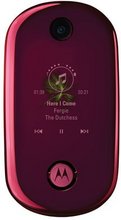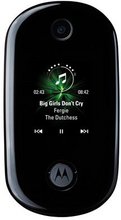Review: Motorola U9
Aug 22, 2008 — by LinuxDevices Staff — from the LinuxDevices Archive — 1 views Motorola's U9 approaches what the Rokr2 should have been all along — a sequel both familiar AND refreshing. Better late than never, the low-cost phone is good enough despite glitches to show that the largest U.S. cellphone maker remains relevant on the global consumer electronics stage.
Motorola's U9 approaches what the Rokr2 should have been all along — a sequel both familiar AND refreshing. Better late than never, the low-cost phone is good enough despite glitches to show that the largest U.S. cellphone maker remains relevant on the global consumer electronics stage.
First, the familiar
The sleek U9 is wider but thinner than earlier Motorola clamshells. Unobtrusive closed, it opens big to position the mike for best sound-quality. It strongly resembles Motorola's earlier non-Linux-based PEBL phone, but slimmed down, and with an OLED external display.
The low-cost “control surface” buttons are large, well-lit, and easy to like. The mix of hardware buttons seems fine, too.





Motorola U9 gallery
(Click any view to enlarge)
Typical of Motorola, signal and voice quality are great, even in the remote, rural area where I live. For some reason, Motorola radios seem to cut through better here, though that's a completely subjective, non-scientific observation on my part.
The software interface, based on Linux and Trolltech Qt, is okay, and if you don't like it, you can customize it quite a bit. Yet, some of the menus seem “dumbed down” — it's not a real smartphone, but a basic feature phone that happens to have some high-end features. These include a decent 2MP camera, video recording/playback, voice recorder, voice dialing, a few cool games, and of course Java support.




The U9 takes a decent snapshot
(Click to enlarge)
There are also lots of data network features, such as multimedia messages, email, a web browser, and readers for office apps. However, no data service is offered where I live, so I was unable to test these features. And, I think most U9 customers will be interested in the device as a phone, rather than as a data device. It's really too small to be a good email reader or web browser.
The “refreshing,” and other novelties
 The U9 has a dazzling external display. Invisible when off, it lets you use your closed clamshell as an MP3 player, camera, or call screener. The completely borderless, organic LED display is mesmerizing, and fun to show off. A crude movie showing the display can be found here.
The U9 has a dazzling external display. Invisible when off, it lets you use your closed clamshell as an MP3 player, camera, or call screener. The completely borderless, organic LED display is mesmerizing, and fun to show off. A crude movie showing the display can be found here.
Like all of Motorola's newer phones, the U9 uses a single micro-USB port for everything from charging to networking/synchronization to audio I/O. So, to enjoy your music, you'll need Bluetooth or preferably wired headphones (which sound better) with a microUSB connector. None of the four phone stores in the small town where I live had such an item, so I cannot report on the U9's sound quality. Its speakerphone is good and loud, though.
To test music playback, I copied some music files to the device over Bluetooth, from a Nokia N810 tablet. This worked fine, using the N810's file manager.
Then, I inserted a 2GB microUSB card that I'd bought for about $10. I'd previously formatted it with a Fat32 filesystem, and had been using it (with an SD adapter) in an N800 tablet. The U9 found and played the MP3s fine — ogg files were not recognized, however.
Next, I found a microUSB cable, and tried transferring files to the phone from my Linux PC. Plugged in, the U9 started charging its battery, and by default presented itself as an MTP device. On my Debian Linux (Lenny) system, having an MTP device plugged in caused the F-spot photo editor to request permission to launch. However, instead of seeing the photos on the device, it saw and wanted to import the MP3s. Talk about seeing the music — “synaesthesia, fella,” as the hippies back in college liked to say.
Supposedly, some Linux music players, such as Banshee and RhythmBox, can deal with MTP. However, preliminary testing with both found that neither recognized the U9 in this mode. Given the rapid pace of open source software improvement, this seems likely to change in the near term.
The U9 can be easily configured to represent itself as a USB “memory card” instead, using the Settings/Connection menu. However, this option did not work for me either. Everything worked fine to a point — the USB subsystem registered a “full speed” (slow, 12Mbps) mass storage device, and an icon appeared labeled “Motorola Msnc.,” presumably short for “Motosync.” But trying to access the device resulted in “device not ready” errors, and no files could be transferred. It may be that the Fat32 filesystem was to blame, although the same card works fine in the N800 tablet configured for USB mass storage mode.
A quick web search revealed similar problems with other Motorola phones running Linux, such as the MotoRokr. So, I quickly gave up trying to use the USB connection with Linux. It's not all that much trouble to remove the card and put it in another device when the time comes to change music.
Still, it's too bad — really the only black eye so far on an otherwise very satisfying consumer device. Perhaps Motorola will fix this via a firmware upgrade, although the U9 does not seem to have any menu selections for updating the firmware over the air.
Linux — what does that mean, exactly?
The U9 is based on Linux, an open source operating system. That does not mean that anyone can fix the software, though — only official firmware will load on the device. So, the sole onus for fixing software glitches rests with Motorola.
Motorola is getting more open, though, in part due to its involvement with the LiMo Foundation, an industry group working collaboratively to improve Linux for use on mobile phones. Any of the LiMo member companies are free to contribute fixes and features to the shared parts of the LiMO stack.
Also, in a historic move, Motorola recently released MotoDev Studio for Linux 0.3, the first-ever release of native tools for Motorola Linux phones. That puts the pieces in place for a world in which you could write your own, say, dialer for the phone, if you did not like what it came with. Or maybe some day, even your own USB storage device driver.
Now that would be refreshing.
A “girl-only” phone?
In scanning the other reviews of this phone, I found several references to the U9 as a “girl-only” phone. Admittedly, the purple color option is a bit florid. But, I have not overheard any snickers, after carrying one for a week. Just because it's small, curvy, colorful, and simple to use does not make the U9 a girl's phone, if you ask me, though I would probably opt for the “graphite” color if buying one for myself. One possible problem for guys and American gals alike — the microUSB port's cover was apparently designed for use by Japanese schoolgirls with miniature fingernails. But, it's nothing that can't be solved with the tip of a pocket knife.
The conclusion
There are bigger, fancier phones. There may be smaller, cheaper phones. The U9 strikes the right balance between the two, with all the features that Linux brings to the table packed into a sensible, friendly form factor that's as refreshing as it is familiar. Despite some quirks, it's a very nice phone that seems like a long overdue update on Motorola's big square “thin” fashion phones of yesteryear.
This article was originally published on LinuxDevices.com and has been donated to the open source community by QuinStreet Inc. Please visit LinuxToday.com for up-to-date news and articles about Linux and open source.